The Definitive Guide to Contract Management
At first, contract management seems self-explanatory.
It’s about managing contracts, right?
While technically correct, behind that definition there’s a multitude of people, processes and moving parts. Over-simplifying what’s involved in good contract management tends to be a common – and sometimes costly – mistake.
Therefore, it’s more useful to think of contract management as the process of getting the most out of your contracts. In other words, you’re managing them as opposed to them managing you!
To show you what we mean, we’ve put together his handy guide to contract management – from basics to brilliance.
Quick Links
1. What Is Contract Management?

Contracts are legally-binding agreements between at least two parties, where each party agrees to meet the terms and conditions laid out in the agreement.
They can take many forms – for example, partnership agreements, sales and lease contracts, and intellectual property agreements.
Contract management, therefore, refers to the process of handling these agreements. Getting them negotiated, written up, agreed upon, signed, and sorted until the expiry date rolls around.
It’s a process that takes place in stages, ideally becoming a connected contract ‘lifecycle’.
2. The Contract Management Process
Effective contract management can only happen with an effective contract management process.
Broadly, the contract management process can be split into six different steps – each with unique challenges as well as opportunities for maximising speed and efficiency.
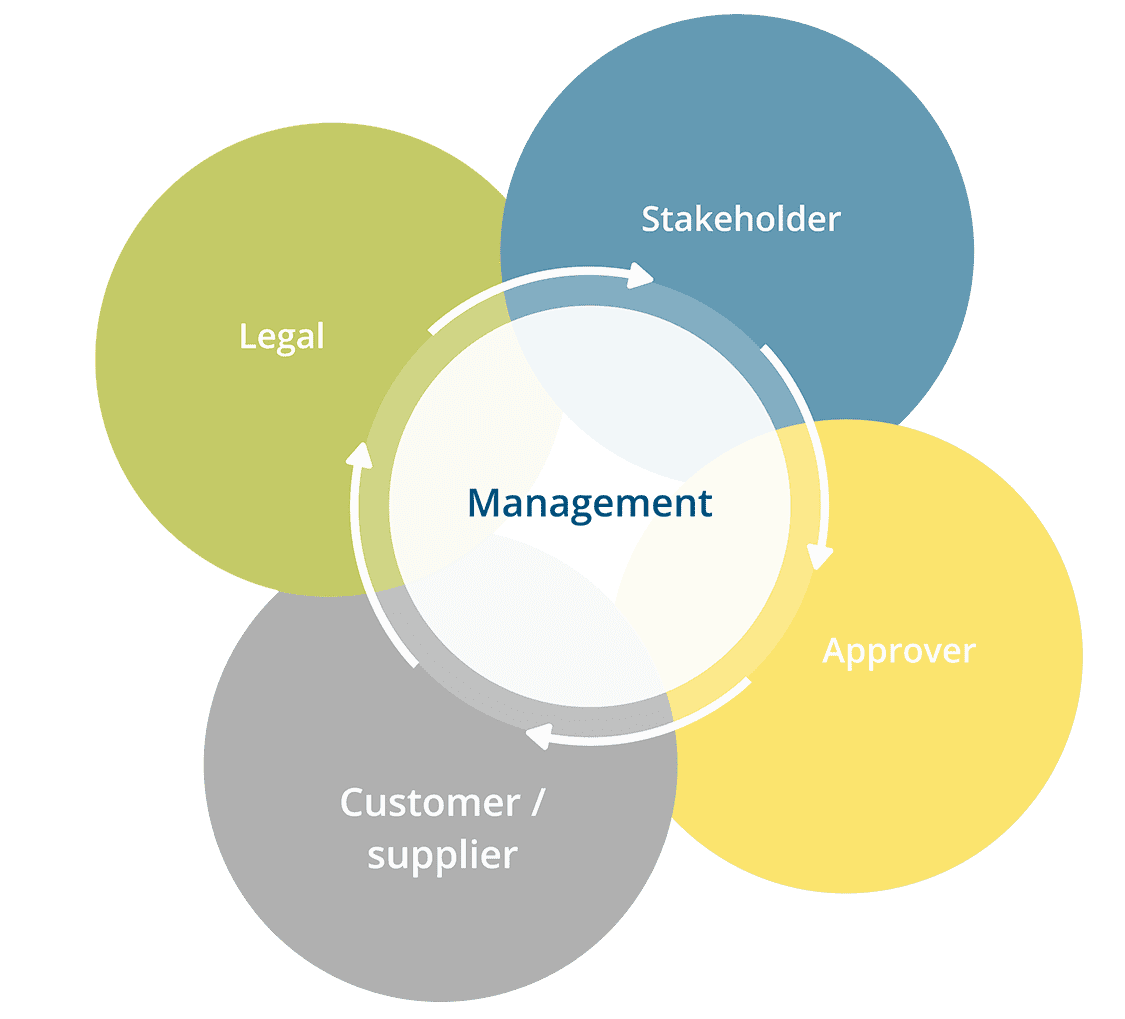
Stage 1: Planning the contract
Planning, preparing, identifying opportunities and risks, and drafting initial terms and conditions.
Contracts are legally binding documents, and therefore need to be treated with considerable care and attention to detail. The planning phase begins the moment two parties decide to do business together, and depending on the contract type may involve:
- Establishing clarity around the need the contract meets.
- Identifying what you ultimately want to get out of the contract.
- Researching the other party’s needs to anticipate what they are likely to want.
- Seeking to identify (and mitigate) as many potential risks as possible.
- Planning for future issues that may arise.
For example, when planning a lease contract it’s important to consider:
- How long the lease will need to last, at what cost, and under what conditions.
- What penalties may be incurred if either party fails to meet these obligations (and where this carries risk for each party).
- What will happen if one party sells their company or files for bankruptcy?
A well-planned contract ensures that each party has absolute clarity about what they’ll get out of the agreement, the conditions they’ll need to meet, and what happens if things change for one or both of them further down the line. No matter how strong your business relationships are, contracts are powerful tools for keeping everyone on the same page.
Stage 2: Authoring the contract
Obtaining a template, getting initial legal advice, and generating the first draft.
The authoring phase involves generating a first draft of the contract using the terms and conditions identified during the planning phase. It’s also the stage where bottlenecks typically begin to arise due to the need for legal involvement.
At the authoring phase, it’s important to ensure:
- All information is up to date.
- The correct terms and dates are used.
- There is no room for ambiguity or interpretation.
- Local laws are carefully considered (this is particularly important if parties are located in different countries or states).
For come contract types, it’s possible to reduce the need for legal involvement at this stage. For example, legal teams can create user-friendly templates for common contracts that include all required clauses and terms.
Stage 3: Negotiating the contract
Discussions around terms and conditions, with a view to getting a final consensus between all parties.
Successful negotiation (or ‘redlining’) depends on three key factors – transparency, trust, and how carefully the planning and authoring stages have been carried out!
During this stage, both parties review the initial draft of the contract, making suggested changes and collaborating towards a final version that’s agreeable to all.
The quickest, easiest way to carry out the negotiation process is to have a system that serves as a ‘single source of truth’ for both parties – where amendments can be tracked and previous contract versions stored to avoid discrepancies and confusion.
Stage 4: Approving the contract
Getting final signoff, which typically involves legal review and may also include audit procedures and/or management approval.
Once both parties have reached an agreement, it’s time to sign on the dotted line. In theory, this should be the simplest step. In reality, that final signature can be frustratingly elusive.
Legal experts typically need to review the final contract – and depending on the size of the company and the importance of the contract, it may also need the approval of executives, management, stakeholders, and/or multiple internal teams.
Then there’s getting the actual signing done, which may involve tight deadlines and incompatible time zones.
This makes the approval stage a common pain point for sales personnel, who understandably tend to want the deal done quickly!

Stage 5: Executing the contract
Implementing the terms set out in the contract and carrying out contract audits to ensure compliance.
Upon signing, the contract terms become a set of instructions for each party – and each will need to have systems in place to ensure those terms are being adhered to. This can involve a great deal of project management, but it’s vital to ensure the contract retains its value.
The workload can also be eased through efficient systems and storage (i.e, not putting contracts in a drawer and forgetting about them)!
For example, maintaining a centralised server where all contracts are electronically stored for easy searching means that multiple staff members and teams can access the information they need to monitor compliance (and ensure they meet their own obligations).
Stage 6: Ongoing contract management, auditing, and renewals
Performing regular audits, running reports, and setting alerts for deadlines and renewals to ensure the contract delivers maximum value.
Contracts might be static documents – but they shouldn’t be treated as such. Instead, they can be thought of directly in terms of revenue, savings, or efficiencies (which of course, translate into revenue or savings)!
Revisions and amendments often come up once the contract takes effect, and these will need to be negotiated and tracked. In addition, alerts should be set for important deadlines – especially end dates or renewals. Most contracts include dates where the contract will either roll over or lapse – and missed deadlines mean missed opportunities, whether that’s a chance to continue a relationship that’s paying off or the chance to get out of an agreement that’s proving costly!
Starting renegotiation early also means there’s plenty of time for unpressured discussions and shows a sense of care and loyalty to the relationship.
3. Biggest Challenges In Contract Management
Successful contract management means overcoming obstacles using the best combination of speed, accuracy, and efficiency possible. Each organisation will face their own unique set of challenges depending on their business type and the kind of contracts involved, but some obstacles are almost universal to the field of contract management.
Here are some of the biggest challenges common to contract management:

Miscommunication (especially between teams)
Because numerous different people and departments need to be involved throughout the contract management process, there are numerous places where communication can break down.
At a minimum, miscommunication reduces efficiency and means more time and effort. At worst, it can result in ruptures that cause the contract to fail.
Human error
Failing to pick up mistakes or amend clauses that are open to misinterpretation can have serious consequences. Depending on the nature of the contract you could run the risk of lost revenue, damaged customer relationships, or legal repercussions. In addition, missed deadlines can mean losing opportunities to renew valuable contracts or get out of costly ones.
Wasted time waiting
When many people are involved in getting a contract over the line, the time spent waiting for them to do their part can add up quickly. Without constant chasing up, precious days or even weeks can be lost – especially if it isn’t clear what each person or team needs to do with the contract.
Slow legal reviews
Legal’s reputation as ‘the department of no’ isn’t particularly fair given the vital role of good legal advice in the contract management process. But given how long legal reviews tend to take, it’s easy to see how other team members and departments become frustrated as the bottleneck builds.

Tracking costs
When contracts are managed manually, it’s difficult – if not impossible – to get an accurate snapshot of costs.
Boilerplate language that’s not fit for purpose
Boilerplate language refers to words or phrases that are standard or generic across contract types. It’s added to contracts for legal protection reasons, and also speeds up the execution of contracts. However, if it’s not reviewed regularly to ensure it meets both internal and external compliance, it can become the very problem it’s used to avoid.
Snail mail (including email)
Printing and mailing a contract for the other party to sign can take days, and emailing isn’t much faster – particularly if there are multiple parties who need to go through the hassle of printing, signing, scanning, attaching, and sending.
Inefficient storage
Many companies still think a bottom desk drawer – or the desktop of a computer – counts as a contract storage solution. In reality, it’s a problem. Contracts are hard to find, easy to forget, and at risk of being lost when people move desks or leave the company. Storing contracts on a central server at least means everyone can access them when they need to, but it’s still not a useful system for performing audits or checking overspending easily. Contract analysis will need to be done manually, with the potential for human error.
Hidden Risks
There’s no such thing as a risk-free contract, but it’s the unforeseen risks that tend to cause the biggest headaches. It’s time-consuming (and impossible) to try and plan for every single possible contingency, but good contract management requires strong systems for identifying and planning for risks.
Missed deadlines
Most contracts include either an end date or a rollover date, meaning that the contract automatically renews if it isn’t renegotiated or terminated. Missing these key dates can be incredibly costly, whether it means losing a good contract or staying locked into one that hasn’t turned out well.

4. Tips for Successful Contract Management
Good contract management happens when everything flows across the entire contract lifecycle. It can help to think of it in terms of a relay race – each party has to finish their part, then hand the baton (or in this case, the contract) on to the next party as quickly and smoothly as possible. Confusion, slowness or inattention at any stage means getting to the finish line slower (and losing ground to the competition).
When each step feeds straight into the next, you achieve maximum efficiency and accuracy – and just as importantly, minimal frustration.
In the last section, we looked at a number of common contract management challenges. Here’s how you can tackle each of them to create a connected, synchronised contract management lifecycle – and see real returns in both time and money.

Improve communication with efficient systems
There are a few ways to try and ensure good cross-department communication during the contract management process.
Many businesses go through multiple process reviews in an attempt to improve their systems, but it’s hard to make these changes stick over time.
Urgency begins to erode rules, frustrated staff find loopholes, and communication breaks down once more.
This is where good contract management software can really shine.
Because the entire contract management lifecycle takes place in one place, and every person involved has complete visibility of the contract pipeline, everybody knows where the contract’s at and when they will need to do their part. It’s easy to pass on info and instructions, send reminders, and view updates.
You don't need a system for good communication any more – the system is the software!
- Business News Daily also offers a helpful guide to avoiding miscommunications and ambiguity through good contract planning.
Minimise human error with automated tools
Good contract management software minimises the risk of human error at every single stage in the contract management lifecycle:
- Templates are provided through an ever-expanding contract repository which is constantly updated.
- Contract reviews can be run with smart AI-driven legal review tools, picking up any areas of concern.
- Automated reminders are sent to ensure deadlines are never missed.
- Sophisticated, secure storage means contracts are always easy to find and up-to-date, with a clear audit trail of previous versions and amendments.
Cut wait times with automated prompts
Using an automated system, like Contract Eagle, means less time spent chasing people to do their part. The contract moves from person to person within the system, along with any notes and instructions needed, and reminders are sent automatically when someone fails to move fast enough.

Speed up legal reviews with templates, alerts and sifting tools
Few contracts need to be drafted or reviewed by a legal professional in their entirety.
Beginning with a template means you’ll cut down immensely on time spent drafting the first version of the contract, and it’s easy to obtain one.
Numerous websites offer contract templates – but if you’re looking for something more comprehensive and reliable, you’ll want to look into contract management software.
Contract Eagle, for example, offers a huge library of common contract templates that’s constantly being updated and added to. You’ll also have the option to customise existing templates in the library or add your own.
Contract review programmes also offer incredible time savings by performing automated legal reviews, which highlight the key passages that need to be looked at by a legal professional.
You can imagine how much quicker it is for a legal team to review three or four paragraphs compared to a 30-page document!
Such programmes also typically pick up on outdated legal terms or non-standard language, an additional safeguard against risk and human error.
LegalSifter is one of the most well-regarded and popular automated legal review tools, with a reputation for excellence and precision that’s very well-earned – and it’s integrated with Contract Eagle’s industry-leading contract management software.
Track costs with contract management software
When contracts are managed manually, it’s difficult – if not impossible – to get an accurate snapshot of costs. Contract management software helps you get a handle on where funds are flowing – and whether or not you’re getting what you expected.
Manage boilerplate language with comparison tools and an up-to-date legal playbook
Regular reviews help ensure that boilerplate language remains relevant, and contract management software makes this process simple by comparing contracts against standard legal playbooks.
Speed up signing with e-signatures
Using a legally binding electronic signature programme (for example DocuSign, Adobe Sign, or Secured Signing) means all signing can be done on-screen. No printing, no scanning, no hassle, no wasted time standing at the printer. Some contract management software – like Contract Eagle – fully integrates with e-signature programmes too, meaning even greater efficiency.
- Read more about DocuSign
- Read more about Adobe Sign
- Read more about Secured Signing
- Learn how Contract Eagle integrates with leading electronic signature platforms.

Manage storage successfully with the right software
A central server, careful naming conventions, and meticulous staff can solve the problem of contract storage – everything is available in one place, up to date, and clearly labelled.
However, there’s still the potential for human error despite the best of intentions. People get rushed or distracted, forget to upload, and you’re back to the drama of stressful searching (or worse, using the wrong contract version).
Choose the right contract management solution, and storage all but takes care of itself. The entire contract management lifecycle takes place within a single central repository, with all versions and all supporting documents stored securely with enterprise-level security.
Remove risks with sifting tools and databases
Legal review tools such as LegalSifter (which comes completely integrated with Contract Eagle’s contract management system) run contract reviews powered by state-of-the-art AI and pick up anything of concern – from outdated legal terms to non-standard language. Using an automated contract management system also allows you to maintain a record of the risks associated with each contract, meaning you’ve got a comprehensive list to check new contracts against.
- Business News Daily offers a handy list of common contract risks to watch for and avoid.
Manage deadlines with automated reminders
When a contract has been signed and stored, you can set up automated reminders for key dates yourself using something as simple as Outlook.
However, the reminders sent by a dedicated contract management system such as Contract Eagle are infinitely more reliable. Firstly, key dates are auto-extracted from the contract, so you can be sure you won’t miss anything important. Secondly, reminders typically include multiple people and require a response – if the first person doesn’t take action (perhaps they’re away on leave or have left the company) the reminder will be escalated to the next person, and the next.
You’ll never miss a deadline again.
Common Contract Management Tools

Spreadsheets
Many businesses have developed systems of contract management that involve simple Excel spreadsheets.
Key dates are added for keeping track of deadlines, key people can access the entire list of contracts, and links can be added to the final contract versions within the spreadsheet (depending on where they’re stored).
Pros: Easy to use and inexpensive.
Cons: Labour-intensive to use well, inefficient, presents numerous risks in terms of data integrity, and relies on manual checking and tracking of compliance and key dates. There’s no easy way of auditing costs, no integrated reminder system, and no way to know for sure if the data is absolutely correct.
- Skyline, an international tourism business, started using contract management software after their spreadsheet system failed. Read Skyline’s story.
Contract Tools
An add-in used with Microsoft Word, Contract Tools provides a variety of features to help analyse and edit contracts. It can highlight errors, alert you to potential problems, manage defined terms, and track incomplete parts of the contract, amongst other tools.
Pros: You’re likely to end up with a document that’s been much more carefully vetted than a human proofreader (with the potential for human error). It’s also quick and relatively inexpensive.
Cons: It’s not intuitively user-friendly, so you’re unlikely to see time-saving benefits in the beginning. Also, Contract Tools doesn’t solve any of the challenges involved in contract storage, communication between teams, tracking previous versions, auditing and reporting, or automated reminders.
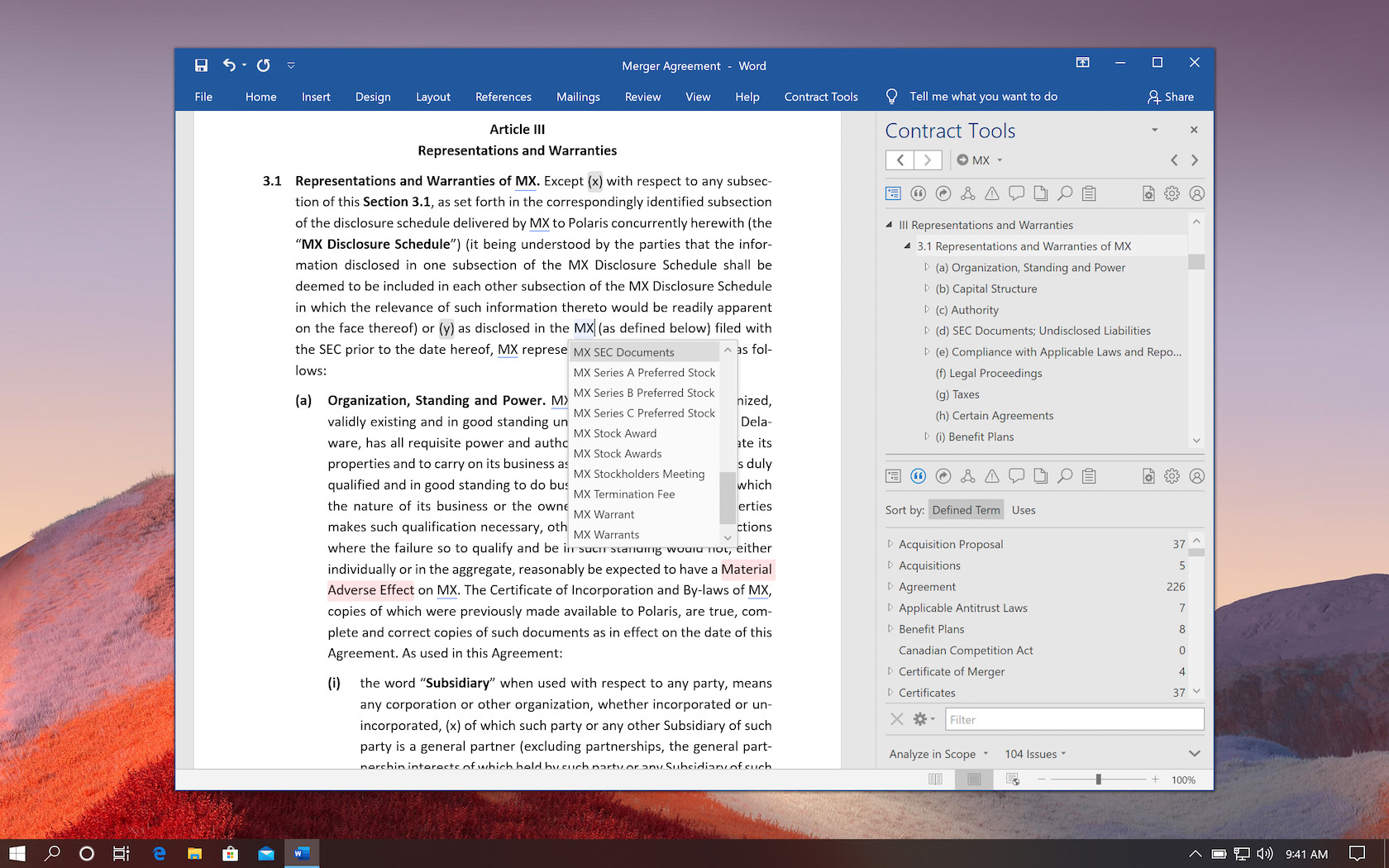
Contract Management Software
Designed to turn the contract management lifecycle into a simple, seamless process that flows almost effortlessly, contract management software empowers businesses to get the very best out of their contracts. With a huge variety of tools and systems that are constantly being refined, updated and added to, contract management software offers a level of performance unmatched by anything else.
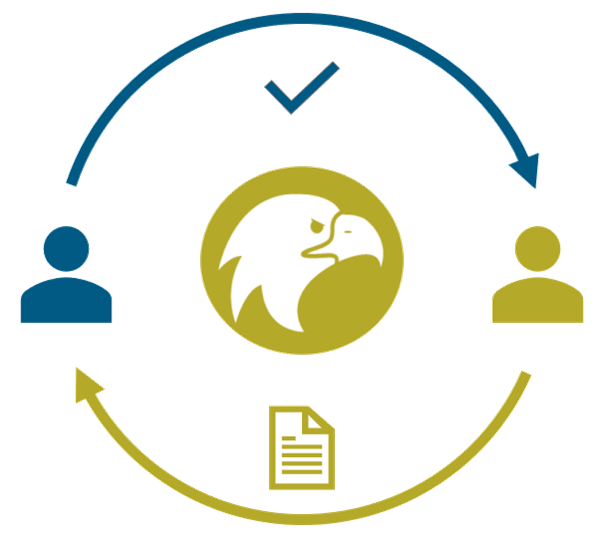
Contracts are completed quicker, meaning businesses see the benefits quicker.
Contracts are more accurate, meaning fewer risks and potential problems.
Contracts are tracked throughout the lifecycle, meaning less frustration, less confusion, less time chasing up, and better team cohesion.
Most importantly, contracts are more likely to be seen as sources of excitement and opportunity (as opposed to frustration and potential liability).
In fact, the Aberdeen Group found that sales teams using contract management solutions tended to outperform non-users in a number of key metrics. This included:
39% higher team attainment of sales quota.
- 35% more reps achieving sales quota.
- 24% shorter sales cycle.
- 20% higher lead conversion rate.
Different contract management providers offer different tools and systems, but here are the pros offered by industry frontrunners Contract Eagle:
Pros:
- Greater efficiency
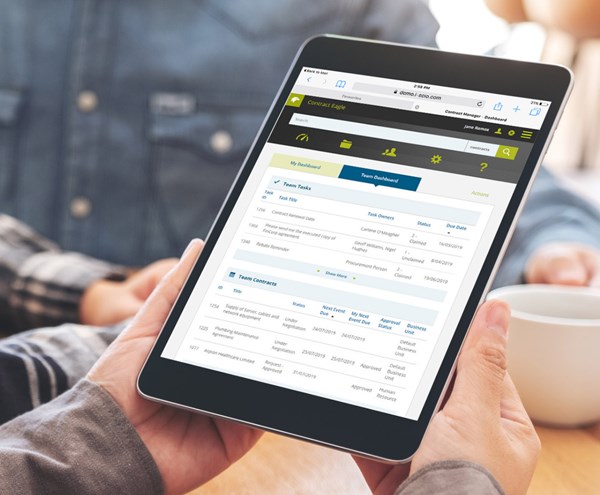
- Automated document creation
- Collaboration and task monitoring tools
- A clear view of the entire contract pipeline
- Smoother negotiations with online redlining
- Automated prompts
- Integration with leading e-signature platforms
- Cloud-based and accessible anywhere
- Free up legal resources
- Better performance
- Powerful searching and reporting functionality
- Single-click reporting
- 24/7 support
- Compliance and cost tracking
- Milestone notifications
- Detailed audit history
- Powerful consolidation
- Visible workflow within a single system
- Secure storage in a single repository
- Tracking of previous versions and amendments
- Reduced risk
- AI-assisted legal review
- AI for auto-extract
- Comprehensive, up-to-date contract library
- Automated deadline reminders
- Enterprise-level security.
"The most important aspect of contract management software is that it allows employees in multiple locations to access contracts in one place."
- Rob Powell, CEO and founder of Rob Powell Biz Blog, Business News Daily.
Cons:
There’s only one real con associated with using contract management software, and that’s the cost involved. But as the old saying goes: if you think it's expensive to do contract management properly, just wait until you find out how expensive it is to do it poorly!
6. Contract Templates
Maintaining a comprehensive contract library can give your team quick access to a wide variety of templates to use as a starting point. Good contract management software will give you access to templates for all common contract types, plus the ability to customise each and add your own.
However, a number of websites offer access to contract templates to help you get started. Here are a few good options to explore:
- https://www.printablecontracts.com/
- https://www.jotform.com/pdf-templates/contract
- https://www.docsketch.com/contracts/
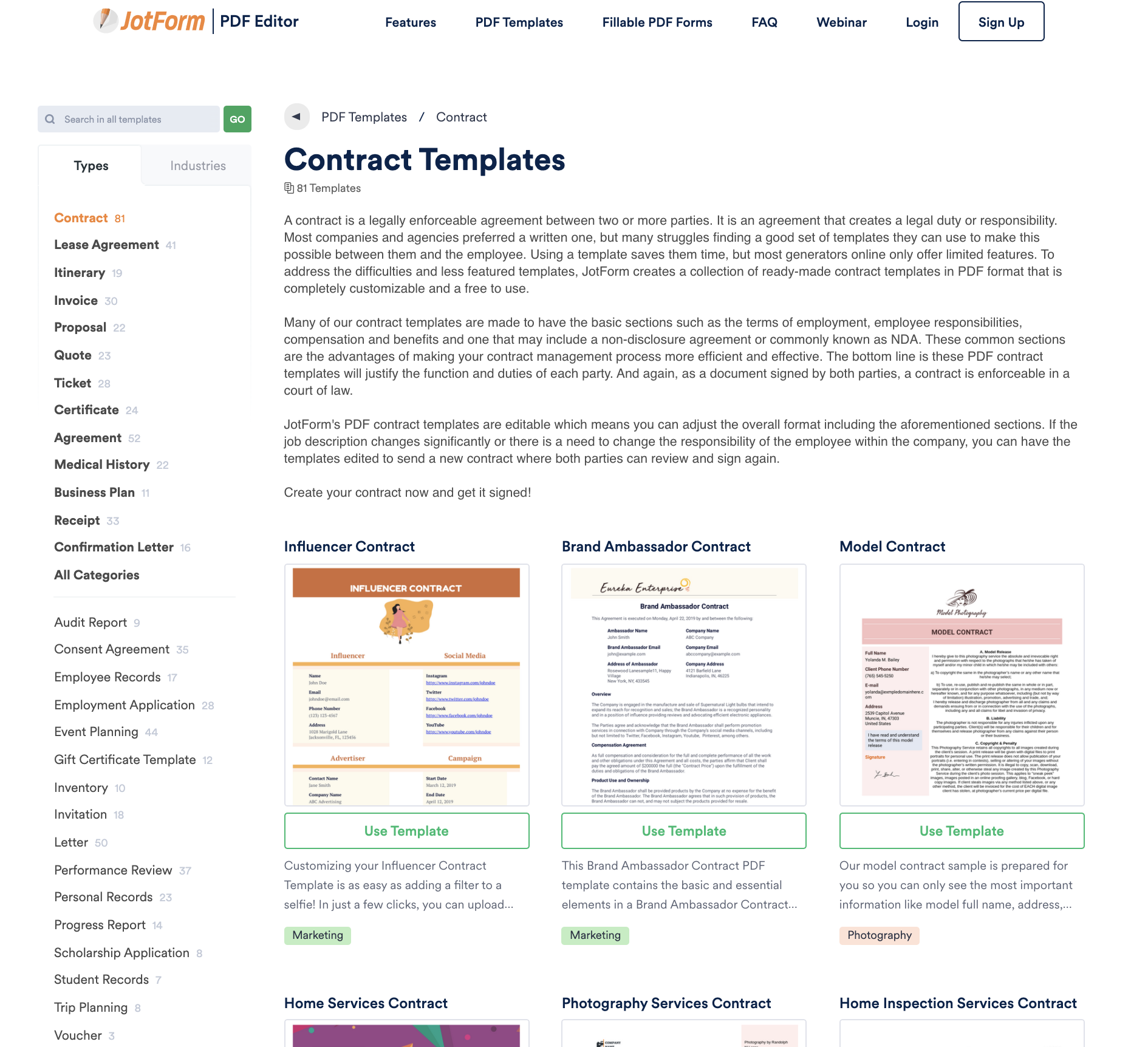
7. The Future Of Contract Management
The future of contract management, like all possible futures, can only be guessed at. But two key areas of new technology are likely to present powerful opportunities: AI and blockchain.
AI (artificial intelligence)
The world of AI has already begun to integrate with the world of contract management – for example, AI powers Contract Eagle’s auto-extract system, which pulls out key contract details to auto-populate databases. AI offers incredible potential for saving time and money while reducing the potential for costly mistakes.
Blockchain
There’s been plenty of buzz around blockchain, but it isn’t well understood. In basic terms, blockchain allows data to be stored, managed and shared between multiple people in a way that’s incredibly secure. It promotes near-absolute data integrity, with implications that could completely revolutionise the way we do business.
In terms of contracts, a business world powered by blockchain means online contracts that are fully transparent and able to be confidently and safely shared. All changes can be captured as a true audit trail, as blockchain can be programmed to record every single alteration with shared visibility between all parties. Plus, the final version can be stored in a digital ‘vault’ that’s immune to tampering.
In other words: visibility and security like never before – to say nothing of speed!
In Summary
Contract management may be a complex, challenging area of business. But that doesn’t mean it has to be experienced as either complex or challenging for you and your team. With the right systems in place and the right tools on hand, contract management can be easy – and we’d love to show you how.
If you'd like to book a demo and start your free trial, get in touch with our team today, and we'll assist you in setting everything up.
It’s brilliantly simple to use, and designed for simply brilliant contract management – in 2020 and beyond.




